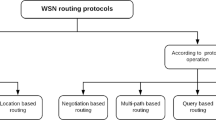Abstract
This paper proposes an effective subtree merging based data collection algorithm for wireless sensor networks (WSNs), named as SMDC algorithm, which can be applied in a new kind of applications in WSNs, i.e., area query application. The SMDC algorithm can prevent unnecessary energy consumption in ancestor nodes for routing through the union of disjoint sets for different subtrees in the network. The SMDC algorithm includes four phases. Firstly the cluster trees are constructed respectively in the target area. Then the disjoint node sets for each subtrees will be found; thirdly the disjoint subtrees are connected via the closest node between two subtrees; and the last phase is to disconnect the subtrees which have been connected to a new tree branch from their previous tree structure. This paper also presents the simulation to compare the SMDC algorithm with some related works including conventional minimum spanning tree algorithm. Simulation results show that the SMDC algorithm can reduce the redundant energy consumption and the number of hops which results in the reduction of total energy consumption. Especially, it is more efficient as the number of sensor nodes in a target area increases.






Similar content being viewed by others
References
Yick J, Mukherjee B, Ghosal D (2008) Wireless sensor network survey. Comp Netw 52(12):2292–2330
Wang L, Xiao Y (2006) A survey of energy-efficient scheduling mechanisms in sensor networks. Mobile Netw Appl 11:723–740
Dilum Bandara HMN (2008) Top-down clustering based self-organization of collaborative wireless sensor networks. Thesis for Degree of Master, Colorado State University
Ai C (2010) Energy-efficient data management in wireless sensor networks. Computer Science Dissertations, Georgia State University
Lee B, Park K, Elmasri R (2008) Reducing energy consumption through the Union of Disjoint Set Forests Algorithm in sensor networks. Lecture Notes in Computer Science, vol 5200/2008, pp 594–603
Solis I, Obraczka K (2006) In-network aggregation trade-offs for data collection in wireless sensor networks. Int J Sens Netw 1(3/4):200–212
Sharaf ALPKCMA, Beaver J (2004) Balancing energy efficiency and quality of aggregate data in sensor networks. Int J Very Large Data Bases 13(4):384–403
Hussain S, Matin Jodrey AW (2005) Energy efficient hierarchical cluster-based routing for wireless sensor networks. Technical Report-TR-2005-011
Yao Y, Gehrke J (2002) The Cougar approach to in-network query processing in sensor networks. SIGMOD Record 31(3):9–18
Demers A, Gehrke J, Rajaraman R, Trigoni N, Yao Y (2003) The cougar project: a work-in-progress report. SIGMOD Record 32(4):53–59
Choi W, Das SK (2004) A framework for energy-saving data gathering using two-phase clustering in wireless sensor networks. In: Proceedings of First Annual International Conference on Mobile and Ubiquitous Systems (MobiQuitous ”04), pp 203–212
Heinzelman WR, Chandrakasan A, Balakrishnan H (2000) Energy-efficient communication protocol for wireless microsensor networks. In; Proceedings of 33rd Hawaii International Conference on System Sciences
Manjeshwar A, Agrawal DP (2001) TEEN: a routing protocol for enhanced efficiency in wireless sensor networks. In: Proceedings of 15th International Parallel and Distributed Processing Symposium, San Francisco, pp 2009–2015
Madden S, Franklin MJ, Hellerstein JM, Hong W (2005) TinyDB: an acquisitional query processing system for sensor networks. ACM TODS 30(1):127–173
Madden SR, Franklin MJ, Hellerstein JM, Hong W (2002) TAG: a tiny aggregation service for ad-hoc sensor networks. In: Proceedings of the Symposium on Operating Systems Design and Implementation, OSDI
Yongwook C, Khan M et al. Energy efficient distributed minimum spanning tree construction: tight bounds and algorithms. http://staff.vbi.vt.edu/maleq/papers/emst.pdf
Khan M, Pandurangan G (2009) Distributed algorithms for constructing approximate minimum spanning trees in wireless sensor networks. IEEE Trans Parallel Distrib Syst 20(1):124–139
Mao Y, Liu Z, Zhang L, Li X (2009) An effective data gathering scheme in heterogeneous energy wireless sensor networks. In; Proceedings of International Conference on Computational Science and Engineering, pp 338–343
Kumar D, Aseri TC, Patel RB (2011) EECDA: energy efficient clustering and data aggregation protocol for heterogeneous wireless sensor networks. Int J Comp Commun Control 6(1):113–124
Ahmed I, Peng M et al (2007) Energy efficient cooperative nodes selection in wireless sensor networks. In: ICPPW, International Conference on Parallel Processing Workshops, p. 50
Yun YS, Xia Y (2010) Maximizing the lifetime of wireless sensor networks with mobile sink in delay-tolerant applications. IEEE Trans Mobile Comput 9(9):1308–1318
Shnayder V, Hempstead M, Rong Chen B et al (2004) Simulating the power consumption of large-scale sensor network applications. Sensys.ACM Press, New York, pp 188–200
Acknowledgments
This research is partially supported by Chinese Government Supported Researchers Plan supported by Japanese Ministry of Education and China Scholarship Council and Grant-in-Aid for Scientific Research of Japan Society for Promotion of Science (JSPS). It is also funded by the cooperation project in industry, education and research of Guangdong province and Ministry of Education of P.R.China (Granted number:2011B090400316).
Author information
Authors and Affiliations
Corresponding author
Rights and permissions
About this article
Cite this article
Lasheng, Y., Jie, L. & Renjie, L. An effective data collection algorithm for wireless sensor network. Computing 95, 723–738 (2013). https://doi.org/10.1007/s00607-012-0249-1
Received:
Accepted:
Published:
Issue Date:
DOI: https://doi.org/10.1007/s00607-012-0249-1




